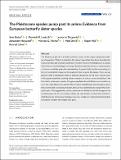Files in this item
The Pleistocene species pump past its prime : evidence from European butterfly sister species
Item metadata
| dc.contributor.author | Ebdon, Sam | |
| dc.contributor.author | Laetsch, Dominik R. | |
| dc.contributor.author | Dapporto, Leonardo | |
| dc.contributor.author | Hayward, Alexander | |
| dc.contributor.author | Ritchie, Michael G. | |
| dc.contributor.author | Dincă, Vlad | |
| dc.contributor.author | Vila, Roger | |
| dc.contributor.author | Lohse, Konrad | |
| dc.date.accessioned | 2021-06-14T12:30:10Z | |
| dc.date.available | 2021-06-14T12:30:10Z | |
| dc.date.issued | 2021-06-02 | |
| dc.identifier | 274374960 | |
| dc.identifier | 1f69e058-557f-433b-88a0-d5be73508b2b | |
| dc.identifier | 85107000401 | |
| dc.identifier | 000656990900001 | |
| dc.identifier.citation | Ebdon , S , Laetsch , D R , Dapporto , L , Hayward , A , Ritchie , M G , Dincă , V , Vila , R & Lohse , K 2021 , ' The Pleistocene species pump past its prime : evidence from European butterfly sister species ' , Molecular Ecology , vol. Early View . https://doi.org/10.1111/mec.15981 | en |
| dc.identifier.issn | 0962-1083 | |
| dc.identifier.other | RIS: urn:AFE0032C90A549DFB9E0858A7FCE58E1 | |
| dc.identifier.other | ORCID: /0000-0001-7913-8675/work/95418426 | |
| dc.identifier.uri | https://hdl.handle.net/10023/23353 | |
| dc.description | Funding: This work was supported by an ERC starting grant (ModelGenomLand). SE is supported by an EastBio studentship from the British Biological Sciences Research Council (BBSRC). KL is supported by a fellowship from the Natural Environment Research Council (NERC, NE/L011522/1). VD is supported by the Academy of Finland (Academy Research Fellow, decision no. 328895). RV acknowledges support from project PID2019-107078GB-I00 (AEI, Spain/ERDF, EU). LD acknowledges support from project ”Ricerca e conservazione sugli Impollinatori dell’Arcipelago Toscano e divulgazione sui Lepidotteri del parco”. AH is supported by a Biotechnology and Biological Sciences Research Council (BBSRC) David Phillips Fellowship (BB/N020146/1). | en |
| dc.description.abstract | The Pleistocene glacial cycles had a profound impact on the ranges and genetic make-up of organisms. Whilst it is clear that the contact zones that have been described for many sister taxa are secondary and have formed during the last interglacial, it is unclear when the taxa involved began to diverge. Previous estimates based on small numbers of loci are unreliable given the stochasticity of genetic drift and the contrasting effects of incomplete lineage sorting and gene flow on gene divergence. Here we use genome-wide transcriptome data to estimate divergence for 18 sister species pairs of European butterflies showing either sympatric or contact zone distributions. We find that in most cases species divergence predates the mid-Pleistocene transition or even the entire Pleistocene period. We also show that although post divergence gene flow is restricted to contact zone pairs, they are not systematically younger than sympatric pairs. This suggests that contact zones are not limited to the initial stages of the speciation process, but can involve notably old taxa. Finally, we show that mitochondrial and nuclear divergence are only weakly correlated and mitochondrial divergence is higher for contact-zone pairs. | |
| dc.format.extent | 15 | |
| dc.format.extent | 1650463 | |
| dc.language.iso | eng | |
| dc.relation.ispartof | Molecular Ecology | en |
| dc.subject | GE Environmental Sciences | en |
| dc.subject | QH301 Biology | en |
| dc.subject | QH426 Genetics | en |
| dc.subject | DAS | en |
| dc.subject.lcc | GE | en |
| dc.subject.lcc | QH301 | en |
| dc.subject.lcc | QH426 | en |
| dc.title | The Pleistocene species pump past its prime : evidence from European butterfly sister species | en |
| dc.type | Journal article | en |
| dc.contributor.institution | University of St Andrews. School of Biology | en |
| dc.contributor.institution | University of St Andrews. Centre for Biological Diversity | en |
| dc.contributor.institution | University of St Andrews. Institute of Behavioural and Neural Sciences | en |
| dc.contributor.institution | University of St Andrews. St Andrews Bioinformatics Unit | en |
| dc.identifier.doi | https://doi.org/10.1111/mec.15981 | |
| dc.description.status | Peer reviewed | en |
This item appears in the following Collection(s)
Items in the St Andrews Research Repository are protected by copyright, with all rights reserved, unless otherwise indicated.

